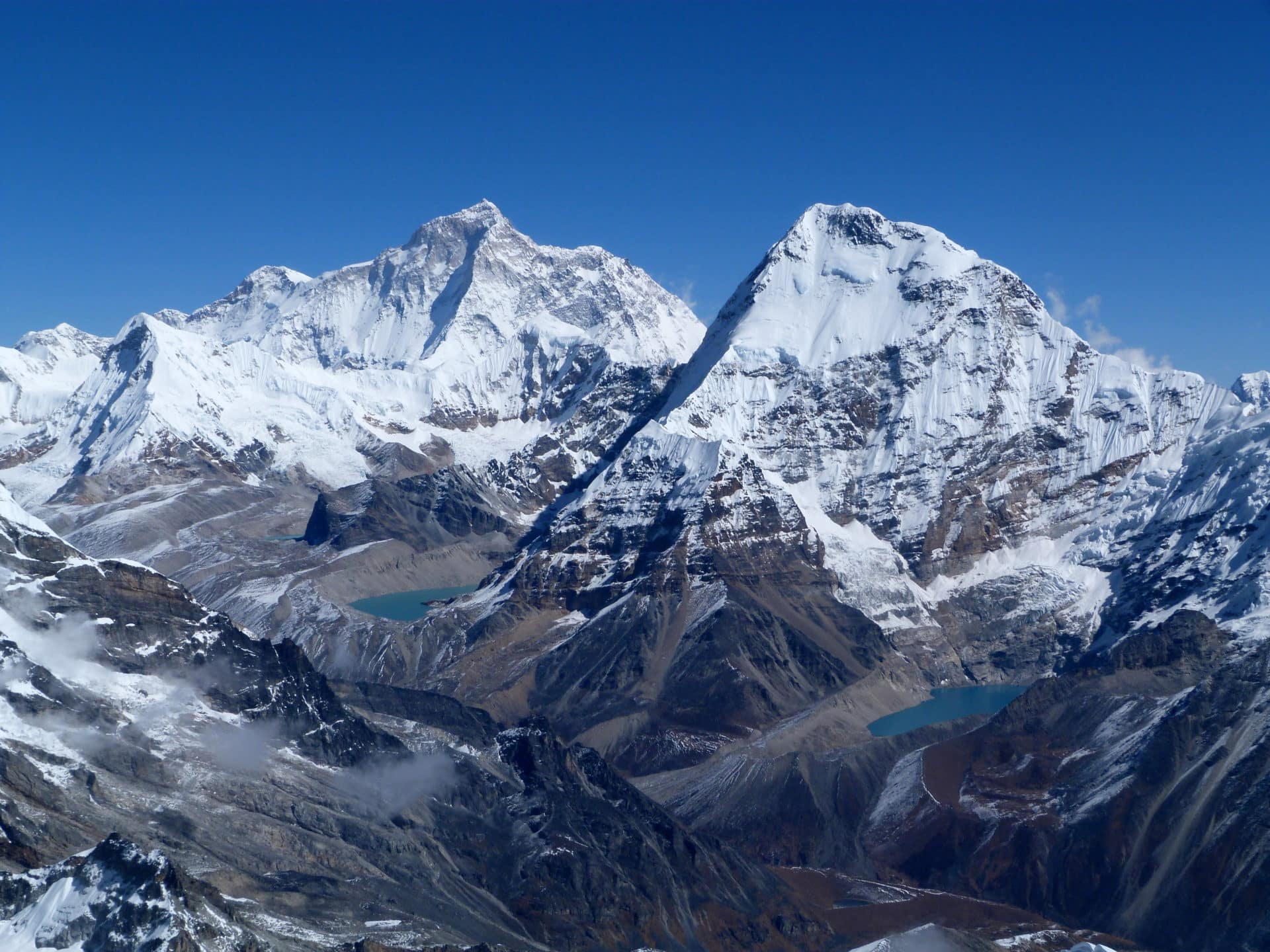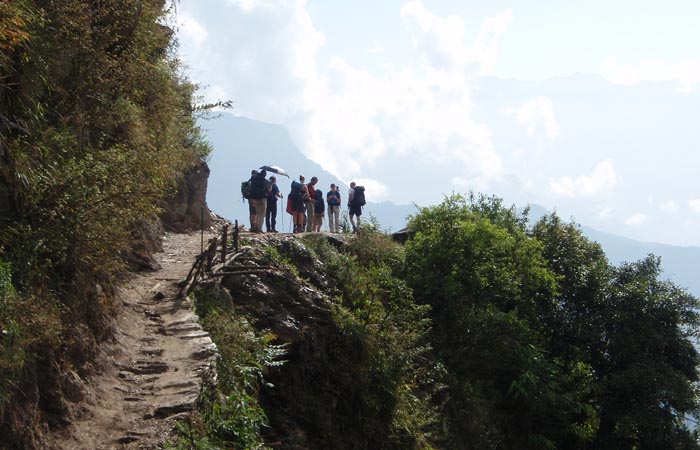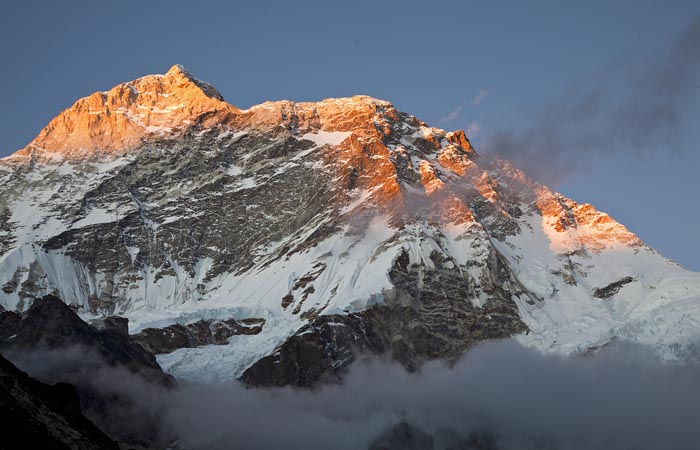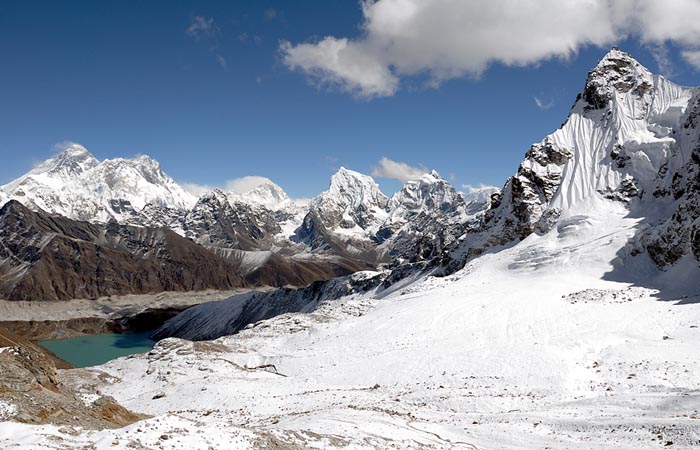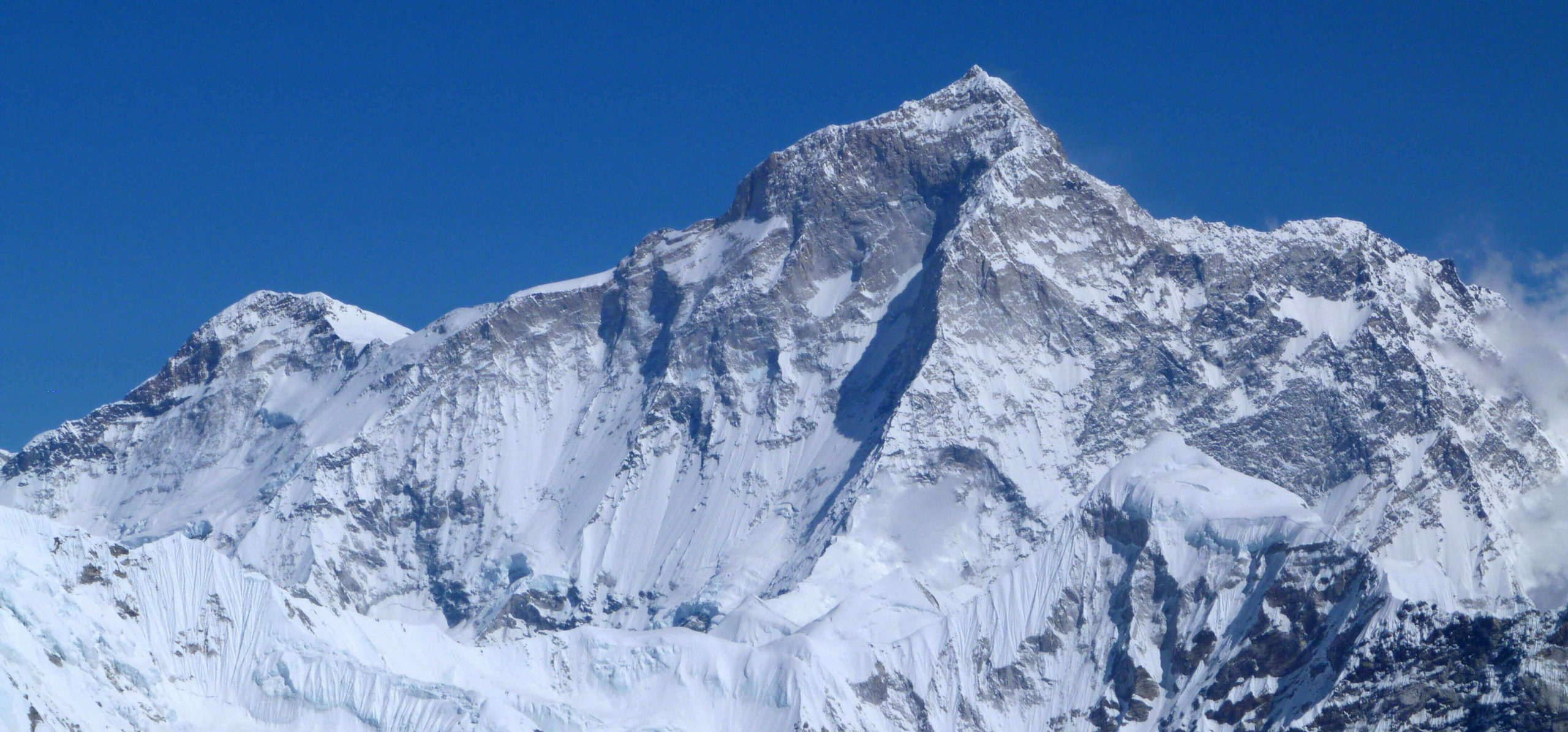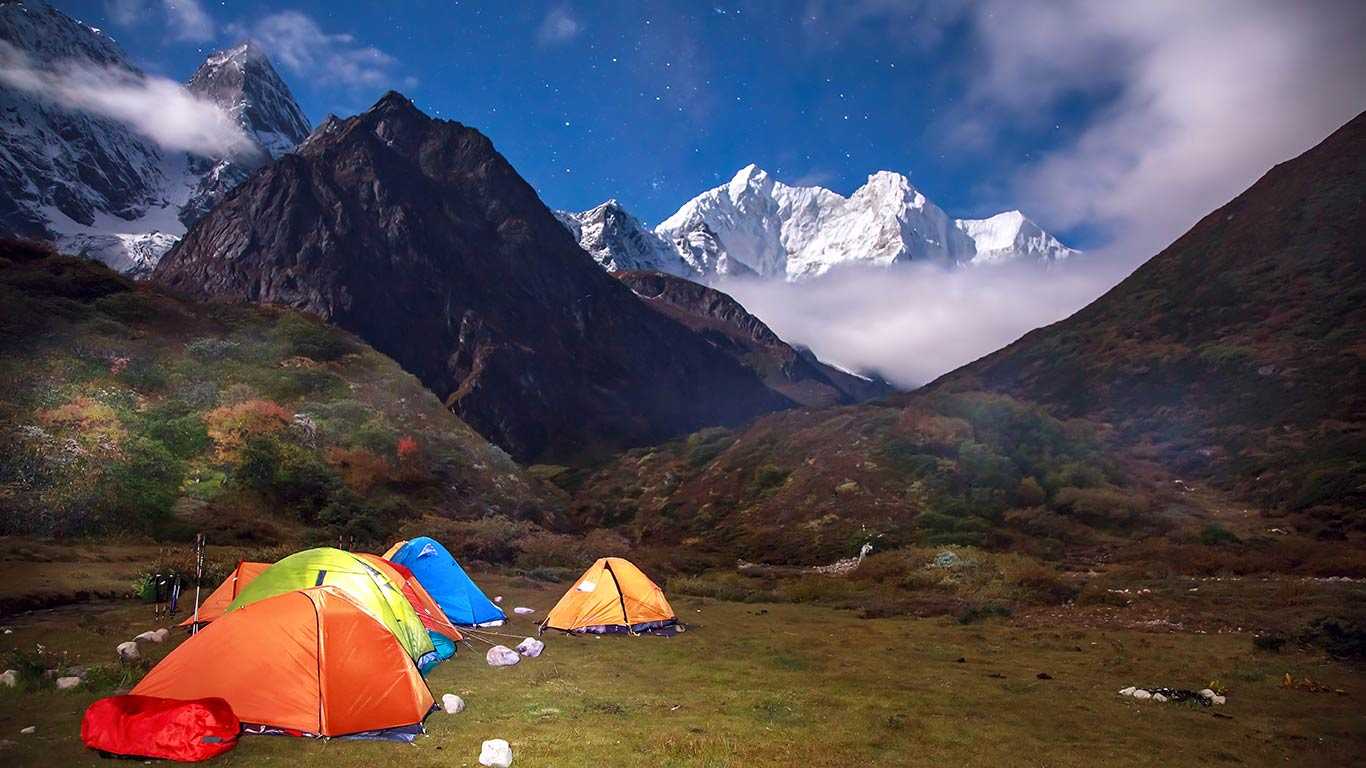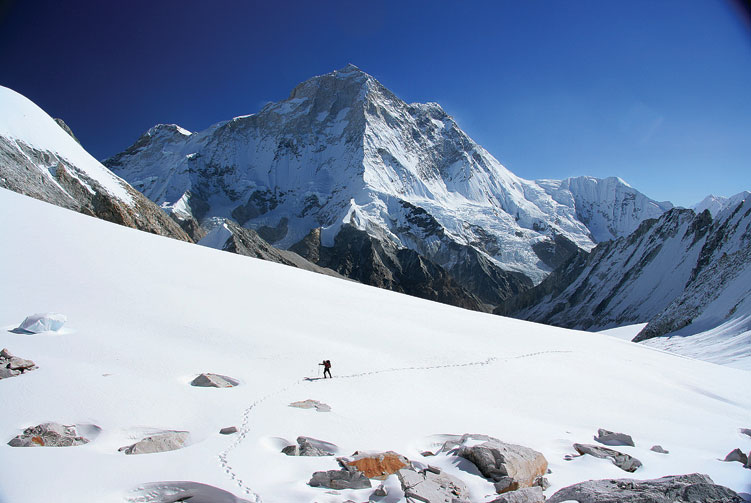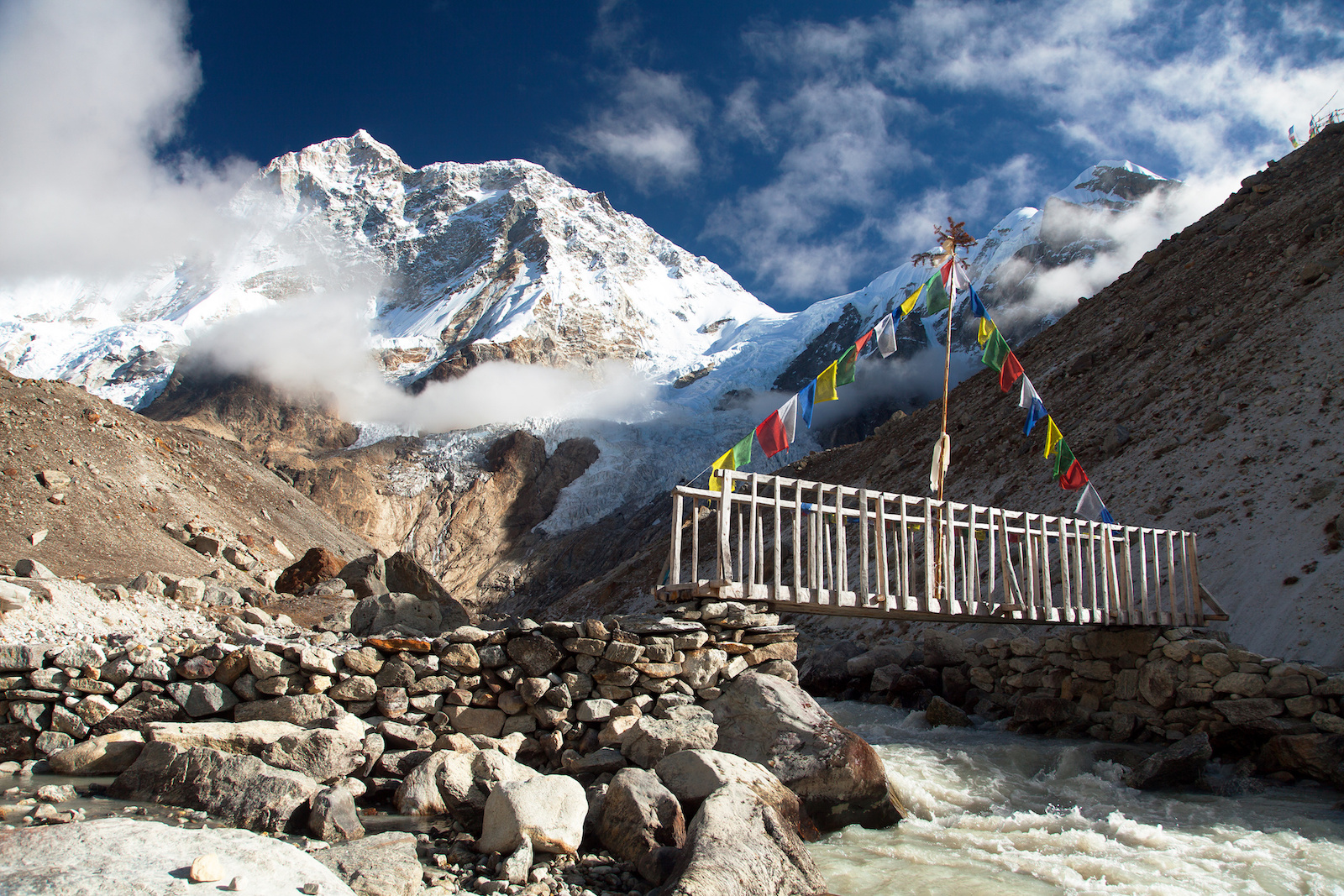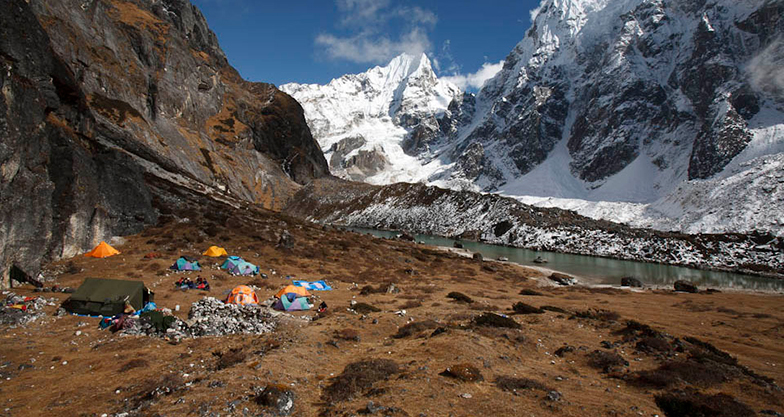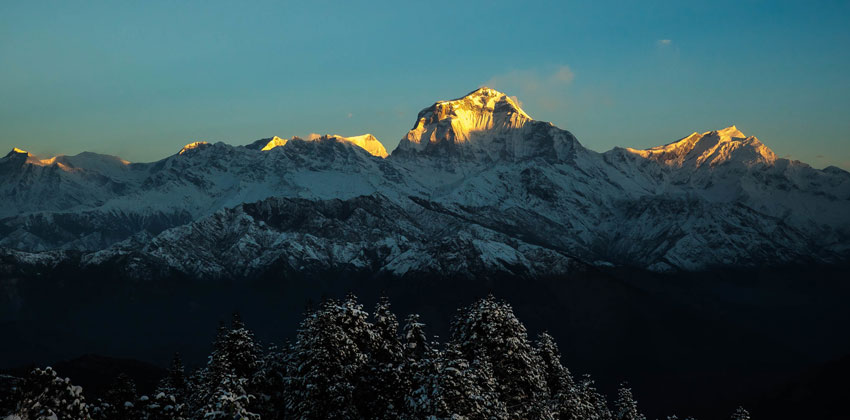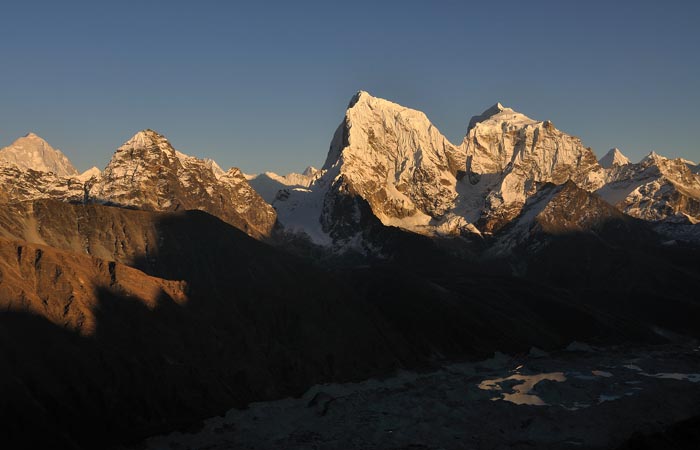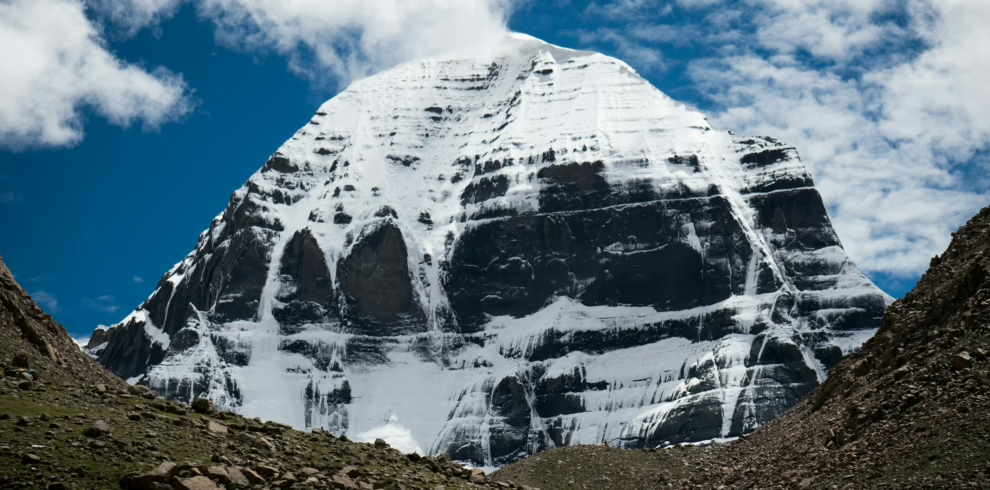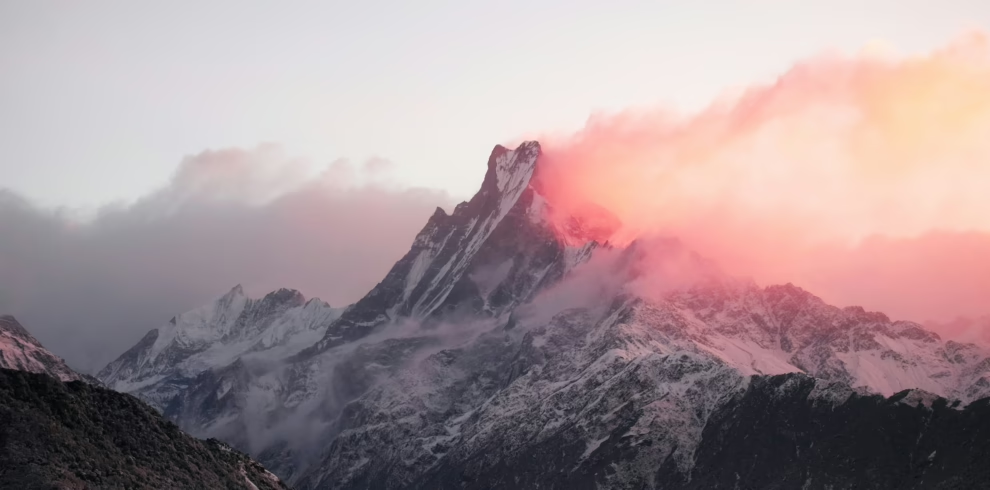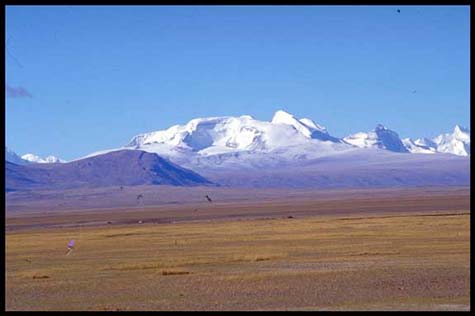The Makalu Base Camp Trekking offers an unforgettable adventure to the foot of Mount Makalu, the fifth-highest peak in the world. Located in eastern Nepal, this trek seamlessly blends stunning natural landscapes with rich cultural heritage, making it a must for those passionate about both outdoor exploration and cultural immersion.
A key highlight of this trek is the chance to explore Makalu Barun National Park. Spanning over 2,330 square kilometers, this protected area is a haven for wildlife, including rare and elusive creatures like the red panda and snow leopard. As you journey through the park, you’ll be treated to jaw-dropping vistas of glaciers, waterfalls, and pristine forests that remain untouched by time.
Beyond its natural beauty, the trek offers a deep dive into the local culture. As you pass through traditional Sherpa villages, you’ll gain insight into the daily life and customs of these resilient mountain people. Known for their legendary hospitality, the Sherpas often invite trekkers into their homes for a warm cup of tea or a delicious meal, giving you a chance to connect with their vibrant way of life.
If you’re seeking an adventure that combines breathtaking scenery with authentic cultural experiences, the Makalu Base Camp Trek is the perfect choice.
19 days / 18 nights Makalu Base Camp trip
Unveil Hidden Trails in Nepal’s Makalu Region
Highlights
- Scenic Flight: The trek begins with a stunning flight from Kathmandu to Tumlingtar, offering panoramic views of the eastern Himalayas, including snow-capped peaks and rolling hills.
- River Valleys: The trail passes through picturesque river valleys, providing rest spots and views of waterfalls and gorges, making it a visual treat.
- Monasteries and Stupas: Along the way, you’ll encounter monasteries and stupas, offering spiritual respite and insight into the region's cultural and religious heritage.
- Mountain Views: Enjoy breathtaking views of Mount Makalu, the fifth-highest peak in the world, along with other stunning peaks like Chamlang, Baruntse, and Ama Dablam.
- High-Altitude Passes: The trek crosses several challenging high-altitude passes, including the Shipton La Pass, which rewards trekkers with magnificent views of surrounding peaks and valleys.
- Challenging Adventure: This trek demands physical fitness and mental preparation but offers an unforgettable adventure with opportunities for personal growth and self-discovery.
- Diverse Landscapes: Traverse lush forests, alpine meadows, and high-altitude deserts, while spotting wildlife like Himalayan tahr, musk deer, and possibly even a snow leopard.
- Rustic Lodges: Rest in welcoming teahouses and lodges that offer a glimpse into local culture and provide a much-needed retreat after long trekking days.
- Cultural Experience: The trek takes you through the culturally rich Solu-Khumbu region, where you’ll learn about Sherpa customs, traditions, and beliefs.
- Warm Hospitality: Expect warm welcomes from local communities, enhancing the trek with their genuine hospitality and making your journey even more memorable.
Itinerary
You will be met at Kathmandu's Tribhuwan International Airport by our representative holding a Green Lotus Trekking placard and transfer you to your hotel. Prior to dinner, a trip briefing will be held. You could spend the rest of the day resting or wandering around the city of Kathmandu.
After breakfast, your Makalu Base Camp Trek guide will meet you at your accommodation for an introduction. During this pre-trip meeting, you'll receive a briefing on the trek and other important details. To obtain your Makalu Base Camp Trek permit, bring your passport, three passport-sized photos, and proof of travel insurance. In your free time, you can relax or explore the Kathmandu Valley for any last-minute shopping. If desired, a tour of a UNESCO World Heritage site, such as Swayambhunath Stupa, Boudhanath Stupa, Pashupatinath Temple, or Kathmandu Durbar Square, can be arranged.
You will be picked up from your hotel and driven to the Kathmandu airport to board a domestic flight to Tumlingtar, marking the start of your Makalu Base Camp Trek. The 35-minute flight offers stunning views of the Alps. After landing, travel for about 30 minutes on a winding, hilly road to Kandbari, a major town housing government offices.
Next, you’ll continue on a winding dirt road, reaching its highest point at 1,960 meters before descending to Chichila at 1,900 meters. This small settlement has a police checkpoint where you'll need to show your Makalu Base Camp Trekking permit. Enjoy views of tree-covered slopes here. From Chichila, the road becomes rocky and deteriorates as you make your way to Num.
Today, you’ll descend steeply to the Arun River and then ascend to Seduwa. The Makalu Base Camp Trek trail follows stone steps all the way to the river at 770 meters, passing through cardamom fields. After crossing the suspension bridge over the Arun River, you’ll begin a challenging climb to Seduwa, through forests of large bamboo and lively village scenes. Your guide will stop at the Makalu-Barun National Park checkpoint to verify your permit. Seduwa is a small village with a school, homes, businesses, and several teahouses scattered along the mountain.
Today’s trek is more relaxed, without the steep ascents and descents of yesterday. As you approach the Sherpa settlement, you'll follow a trail with stone steps, passing several mani walls. The route takes you through rhododendron and bamboo forests, with small farms and cardamom plantations scattered across the slope. The trek is varied and interesting, and after about two hours, you'll reach the village of Chyaksa Danda at 1,900m.
You may need to cross streams on sturdy wooden bridges as you walk through dense forest. Although the journey takes longer than expected due to the uneven trail, you’ll eventually spot your destination, Tashigaon, on the slope ahead. Finally, you'll descend to a log bridge before tackling the last climb up stone stairs to Tashigaon.
You will leave Tashigaon and climb up some stone stairs to start your Makalu Base Camp Trek. You eventually cross a log bridge and keep climbing through a breathtaking rhododendron woodland. You arrive in Dhara, which has a tea house and is located at 2,867m, after traveling for about three hours. Since this is your only opportunity to stop for refreshments until reaching Khongma, you probably have your lunch there.
After leaving Dhara, it takes about an hour of difficult climbing to reach Unshisa at 3,200m, where you cross a huge rock. More arduous hiking on stone stairs through a rhododendron woodland is required from Unshisa. After several hours of laboriously climbing from Unshisha, you finally arrive at a stone rest area with prayer flags, and another 45 minutes of walking will take you to Khongma Danda at 3500m. There are three lodges in Khongma, and this location could also have a lot of snow.
We highly recommend ascending to Khongma La today for proper acclimatization, which is crucial for your trek. According to your itinerary, today is dedicated to acclimatization. After leaving your teahouse, you'll hike through rhododendron bushes and ascend stone stairs to reach the pass at 3,890m, which should take about an hour. If you're feeling up to it, your guide may encourage you to continue further. Afterward, you’ll return to Khongma, well-acclimatized and ready to tackle the four passes, starting with Khongma La tomorrow.
Today offers an exciting challenge as you cross four high passes, each with stunning ridge walks and panoramic views of snow-capped peaks. The first pass, Khongma La at 3,890m, is reached after an hour of climbing through rhododendron forests, offering views of Makalu and Chamlang. Your route then descends briefly before ascending the second pass, Sano Pokhari Danda at 4,105m, with Sano Pokhari Lake below.
Next, you’ll navigate several undulating stretches before reaching Shipton La at 4,200m, marked by a mani wall and cairn. You’ll then descend to Kalo Pokhari Lake at 4,080m, a site adorned with prayer flags, especially visited by Hindu pilgrims during the Janai Purnima Festival. The final pass, Keke La at 4,170m, is a manageable ascent from the lake. After another 45-minute descent, you’ll reach your lodge in Dobate, a well-deserved rest after the four-pass challenge.
This morning’s descent takes you through enjoyable rhododendron and pine forests. The trail has a steep section that could be slippery if there’s snow. Eventually, you’ll reach the river and begin your trek along a trail beneath a large landslide area. After a short climb, you’ll arrive at Themathang Kharka (3,500m), where you’ll stay overnight.
The trek from Dobate to Themathang takes about four hours. Just before reaching Themathang, you’ll pass a beautiful waterfall. Afterward, continue on until you cross a wooden bridge over the Baron Khola river. The path then undulates, with the river on your left. From here, it’s about 1.5 hours to reach your lodge in the meadows of Yangri Kharka.
The walk is pleasant and level, with the river on your left and the scent of juniper in the air. The trail is adorned with vibrant prayer flags. Ahead, the towering cliffs give way to stunning views of Peak 4, Peak 6, Peak 7, and Yaupa. Today’s trek offers a visual feast of rugged snow-covered mountains, sheer cliffs, waterfalls, and sacred caves.
After about 2.5 hours, the trail widens as you pass the fields of Jhak Kharka, Yak Kharka, and finally Merek, where a welcoming tea house comes into view. From Merek, it’s about two hours to Langmale, where your tea house awaits. Peak 7 provides a breathtaking backdrop to the lodge, and a prayer flag-adorned mani wall stands just in front of the rooms.
Begin your ascent on a solid path for your Makalu Base Camp Trek. As you zigzag through the valley, keep the river on your left. Each corner reveals a new stunning view. While some sections require stepping over boulders, most of the trail is a smooth, sandy path. As you continue, Peak 4 comes into view. After a few hours of trekking, you'll reach Shershong at 4,630m. This broad, flat area, with a lockable stone house, makes a great campsite. The breathtaking sight of Makalu soon appears.
As you navigate a few curves, the base camp becomes visible. After crossing the river, your long-awaited goal is just five minutes away. Makalu, the fifth-highest peak in the world, dominates the landscape. Around the base camp, you may spot Tibetan snow cocks, hill pigeons, black redstarts, and mountain finches.
Today, you'll reach a ridge at around 5,300 meters above base camp, offering stunning panoramic views. After crossing the river via a log bridge, you'll climb a faint, unclear trail for about three hours. From this vantage point, enjoy spectacular views of Makalu, Peak 7, Peak 6, Peak 4, and distant peaks like Everest, Lhotse, and Nuptse. After soaking in the sights, return to base camp by retracing your steps.
The round trip takes 4-5 hours. It's a challenging trek due to the steep terrain and high altitude, over 5,000 meters. For a gentler option, consider visiting the lakes beyond base camp or climbing a shorter ridge just above base camp. Alternatively, there's a small hill with prayer flags about an hour's walk from the base camp.
With a heavy heart, you'll leave the majestic Mount Makalu behind and begin your trek back to Yangri Kharka. After about 1.5 hours, you'll reach the Shershong meadow, marked by a cabin with a bright orange tarp. Another 1-2 hours of walking will bring you to Langmale, where you can enjoy tea and possibly lunch.
Next, after about 1.15 hours, you'll reach the Merek tea house. It's a good place to relax with a cup of tea before continuing your journey through pine trees back to Yangri Kharka. The trek from Merek to Yangri Kharka takes about 2-3 hours.
Today, you'll enjoy a leisurely walk along the river to the tea house at Themathang, passing through rhododendron shrubs. Before reaching Themathang, you'll cross a wooden bridge. The trek takes about 1.5 hours.
Next, you'll navigate a landslide area for about 1.5 hours. After some undulating terrain, you'll begin a challenging ascent through rhododendron forests. As you approach the Dobate tea house, the trail gradually levels out.
According to your Makalu Base Camp Trek itinerary, today offers your final opportunity to take in breathtaking views of towering peaks, including Kangchenjunga.
Your ascent to Keke La takes about 1.5 hours, followed by another 1.5 hours to reach the Shipton La at 4,200 meters. After an additional hour, you'll reach the large cairn marking Sano Pokhari Danda at 4,105 meters.
Next, you'll descend to Khongma La at 3,890 meters, marked by a mani wall. This takes about an hour, and you'll descend roughly 250 meters, mostly on stone steps. Keep an eye out for the elusive blood pheasant in the snow-covered rhododendron bushes. From Khongma, you'll continue your descent to Danda Kharka, a further two hours away.
As you descend from the mountains back to civilization, you'll have time to reflect on your unforgettable adventure. The three-hour journey from Danda Kharka to Tashi Gaun takes you through rhododendron forests, steep terrain, and meadows, offering beautiful mountain views. From Tashi Gaun, you'll cross terraced farms before leaving the Makalu-Barun National Park. The route then follows the Barun River through bamboo and rhododendron woods, leading to Seduwa, where you'll spend the night at a local lodge.
Today, you'll take a short, scenic flight from Tumlingtar to Kathmandu. Upon arrival, you'll be transferred to your hotel. In the evening, Green Lotus Trekking will host a farewell dinner to celebrate completing the Makalu Base Camp Trek. You can spend the rest of the day exploring the city or shopping for souvenirs.
You will be transferred from your hotel to the airport in a private tourist vehicle three hours before your scheduled flight. If you wish to extend your stay, you can choose another package offered by Green Lotus Trekking.
Includes/Excludes
Cost Includes
- Airport pick-up and drop-off service (Kathmandu International Airport)
- 3 nights’ accommodation in a standard Kathmandu hotel
- Flight to/from Tumlingtar
- Tea house/homestay accommodation during the trek
- Breakfast, lunch, and dinner during the trek
- Professional English-speaking guide
- All necessary paperwork and permits
- Government and local taxes (if applicable)
- Farewell dinner
Cost Excludes
- International airfare and Nepal visa fee
- Excess baggage charges
- Lunch and dinner in Kathmandu
- Travel/medical insurance
- Porter (optional, available for booking)
- Personal expenses (phone calls, laundry, bar bills, extra porters)
- Tips for guides and porters (expected at the end of the trek)
FAQs
You can find good places to trek somewhere in the Himalayas at anytime of the year. However, for most regions, the best time is from October to May, with October to November having the best weather for trekking. During the autumn, nights are cold in the high Himalaya, but the bright sun makes for a pleasant daytime temperature (20 degrees centigrade to 5 degrees centigrade in the night). Above 3500m, the temperature range goes down to -10 degrees centigrade, and in winter (Dec-Jan), it is about 10 degrees colder.
While you do not need to be super-fit, you need to be fit enough to comfortably walk for 5–6 hours per day in the mountains on reasonable trails. Most of our customers have an interest in walking in the hills or countryside of their homeland and are used to similar daily trips.
We pride ourselves on our small group approach to adventure travel. Small groups allow you to share great company without crowding your experience. Our typical groups range in size from 2 up to 8. One of the attractions of such a trip is the chance to meet people with different backgrounds and personalities.
If this is the case, we can organize a personalized trek for you. Additionally, if you want to spend more time in Kathmandu before or after a trek, we can organize the hotels and quote you a price.
If you are a group of four or more, the trip is guaranteed to run.
Usually, our clients simply bring their existing clothing and equipment and, if necessary, supplement this with some extra items purchased cheaply in Kathmandu.
What gear to bring?
- Passport (with photocopies)
- Photos for Nepal visa on arrival:
- Travel insurance (with photocopies)
- flight tickets (photocopies)
- Daypack for daily personal items
For Trekking:
- Walking boots
- Light sandals or plimsolls to wear in the lodges
- 2 pairs of underwear.
- 2 pairs of walking socks.
- 2 thick fleece or warm shirts
- 1 pair thin thermal underwear
- Long trousers for walking (or a long skirt for women)
- T-shirt
- Shorts
- Gloves (it’s cold on the Thorung La, Laurebina Pass and Cho La)
- A warm hat which covers your ears (for the Kali Gandaki and Thorung La – it’s windy)
- Base ball caps or broad brim hats to keep the sun off (Australian Barmah recommended)
- Sunglasses (vital)
- Sun cream
- Soap dish and soap
- small towel
- Toothbrush and toothpaste.
- Wet wipes or moist towelettes
- Hand sanitizing lotion
- Head torch
- Moisturizer, Lip balm
- Tampons are hard to buy in rural areas.
- Ear plugs for light sleepers
- Toiletries
- Sheet of plastic (use as a poncho if it rains)
- 1 toilet paper roll. You can buy more on the way.
- 2 large plastic bags. One for smelly clothes, one for things that must be kept dry.
- A small, good quality padlock
- Water bottle
- Iodine tablets for water purification
- Protein bars, chocolate, dried fruits, candies, and snack foods.
Notes: All of the trekking items are available in Kathmandu at nominal prices. However, we suggest you bring hiking boots from your home country if you decide to purchase these items in Kathmandu.
Yes, all hotels provide storage facilities for free.
Personal travel insurance is not included in the tour price. It is a condition of booking a tour with Green Lotus Trekking, and your responsibility to ensure that the type of tour you are undertaking, the policy must include satisfactory cover for repatriation, high altitudes, trekking and climbing, and helicopter rescue. Please forward your insurance details (e.g. policy number, 24-hour emergency telephone number, and name of insurance company) to Green Lotus Trekking when available.
Yes. You can apply in your home country through the Nepalese Embassy or Consulate or obtain it at the airport on arrival by paying a fee as below:
- Multiple entries for 15 days: $25 USD
- Multiple entries for 30 days: $40 USD
- Multiple entries within 90 days: US $100
Notes: We suggest you bring the exact change. You also need to bring two passport-size photos.
Tourist Visa Extension
The visa extension fee for 15 days or less is US $ 30 or equivalent convertible currency, and the visa extension fee for more than 15 days is US$ 2 per day.
A tourist visa can be extended for a maximum period of 150 days in a single visa year (January–December).
Gratis (Free) Visa
A gratis visa for 30 days is available only for tourists from SAARC countries.
Indian nationals do not require a visa to enter Nepal.
I am a single traveler. How does this work?
Normally, single trekkers have no problems fitting in with a group. Normally single trekkers share rooms or lodges with other trekkers of the same sex, but if we have an odd-number we ensure that a room or lodge is organised accordingly.
To confirm your booking, we will require a deposit of $250 for treks and $300 for peak climbing, which can be made by bank transfer or online through paypal.com (the leading transaction site). The balance is payable on arrival in Kathmandu with cash or traveler’s cheque. Alternatively, the balance can be paid by bank transfer or PayPal shortly before arriving in Kathmandu.
The following details are needed to process your trekking permit, national park permit, flight booking etc.
- Gender:
- First Name:
- Last Name:
- Passport number:
- Expiry date:
- Issue location:
- Nationality:
- Year of birth:
- Occupation:
- Your arrival details (time, date, flight number, airline):
All the above info can be sent electronically via email.
You will typically walk 4–9 miles (5-8 hours) each day. Some days may be rest days for impromptu exploration. In high and steep areas, you may move more slowly. Most people begin to feel the effects of high altitude over about 2000 meters, and your trekking pace is always adjusted to permit safe acclimatization. Our treks follow established trails used by local people. You will probably carry only a light daypack.
You can hike at your own pace, stopping when you wish. There is ample time to cover the necessary hiking distance each day with lots of stops. If you are on a private trek, you may wish to take more or fewer days to cover a given distance, or add in rest days. If you like to hike fast, your guide will be concerned that you acclimatize to high altitude effectively. You may wish to reach camp at a measured pace, but take a side hike after arriving at camp. Your guide is always interested in learning about your personal interests and accommodating those interests as the trip permits.
Altitude sickness, often known as acute mountain sickness (AMS), is a particularly important medical consideration while trekking in Nepal. Altitude sickness means the effect of altitude on those who ascend too rapidly to elevations above 3000 meters. The initial symptoms of AMS are as follows:
- nausea, vomiting
- Loss of appetite
- Insomnia or sleeplessness
- Persistent headaches
- Dizziness, light headaches, confusion,
- Disorientation, drunken gait
- Weakness, fatigue, lassitude, heavy legs, slight swelling of hands and face.
- Breathlessness and breathing irregularly
- Reduced urine output
These symptoms are to be taken very seriously. In the event of the appearance of any of the above symptoms, any further ascent should be reconsidered; otherwise more serious problems can occur, which can cause death, sometimes within a few hours. The only cure for altitude sickness is to descend to lower elevations immediately. Acclimatization by ascending to no more than 300 to 500 meters per day above 3000 meters and the proper amount of rest are the best methods for prevention of AMS.
Our itineraries are designed so that our clients ascend at a sensible and safe rate. The effects of altitude are felt by everyone, even the Sherpas, but most people find that gentle acclimatization allows them to reach their high point without any problems.
Accommodation: There are a number of lodges along the popular trekking routes in the Annapurna, Everest, and Langtang regions. These lodges are called “Tea House Lodges” and are managed by local people. Private rooms, dormitories, toilets, shower rooms with hot and cold water, and one attached restaurant are among the basic requirements for overnight accommodation at these lodges.The quality of food offered might vary from lodge to lodge, but most serve simple and hygienic meals. The teahouse trek provides you an opportunity to feel the warm hospitality of friendly Nepali hosts. The money you spend goes to the local community.
Camping Trekking
In a typical camping trip, each pair of trekkers will sleep in a spacious mountain tent with a durable rain fly and full insect netting. The tent is fitted with foam mattresses. When your campsite is near villages or lodges, you may be invited to sleep in the lodges or homes of local people.
Breakfast options include oatmeal,French toast,Chapatti, Tibetan bread, eggs, pancakes, muesli, and for lunch or dinner you can have sandwiches, soups, momo (dumplings), macaroni dishes, pizzas, noodles, steak, dal bhat (rice, lentil, veg platter), pasta, etc.
Our trekking guides are carefully selected for their ability and are generally from Sherpa, Tamang, Gurung, Magar, and other communities from remote mountain villages. Each guide is trained in eco-friendly trekking methods and safety measures. They help to maintain your health and your happiness as well as the crew members. Our guides are committed to making sure that all our trekkers have an enjoyable trek, come back safe and are overwhelmed by their experience. Your guide will be a friend and companion, who takes pleasure in showing you his country’s specialties and, perhaps, meeting his home and family too.
The majority of the fees our clients pay go directly into the community where you trek.
Tipping is at your discretion and always appreciated. A good rule of thumb is anywhere from $2–5 dollars per day for the guide and $1.5–3 dollars per day per porter. The total amount can then be divided among the group.
Please have them contact us at any of the following numbers:
Cells: +977-9841250258, +977-9841269376
We check email frequently throughout the day, so you could also write to our email: info@green-lotus-trekking.com if it’s not urgent.
Map

The Makalu Base Camp Trekking is a demanding journey that requires good physical fitness. The trail can be challenging, especially at higher elevations, but reaching the base camp makes the effort worthwhile. The best seasons for the trek are spring (April-May) and autumn (September-November), offering mild weather and clear skies. Although remote, the route is well-equipped with basic lodges and tea houses, making it accessible for trekkers of all fitness levels and experience.
The 19-day Makalu Base Camp Trekking begins with a domestic flight from Kathmandu to Tumlingtar, a small town in the Sankhuwasabha district. From there, the trail ascends gradually through lush forests of rhododendron and bamboo, passing villages like Chichila and Num. You’ll cross several suspension bridges over the Arun River, enjoying stunning views of the river and valleys. Along the way, you’ll have the chance to interact with local communities, learning about their customs and culture.
As you progress, the landscape shifts to rocky, barren terrain. You’ll pass through Shipton La and Keke La passes, which offer panoramic views of the Makalu region’s peaks. The final stretch takes you through Yangri Kharka, Langmale Kharka, and Shershong to Makalu Base Camp at 4,870 meters. Here, you’ll stand at the foot of Mount Makalu, marveling at its sheer size. The trek then descends into the pristine Barun Valley, surrounded by towering peaks, and retraces the route back to Num. From Num, you’ll take a jeep or bus to Tumlingtar, then fly back to Kathmandu, completing your trek.
At Green Lotus Trekking, we offer a well-planned Makalu Base Camp Trek Itinerary, ensuring an unforgettable experience. Bookings are open for 2025 and 2026, and we’re happy to customize the trek based on your time, budget, and fitness level. For more details on costs, feel free to contact us.
Benefits of Booking the Makalu Base Camp Trek with Us:
- Airport pickup and drop-off (International and Domestic)
- Free Makalu Base Camp Trek map
- Oximeter to monitor blood oxygen levels
- Medical kits for emergency use
- Free luggage storage at Green Lotus Trekking store during the trek
What to Expect from the Makalu Base Camp Trek?
The Makalu Base Camp trek is a rewarding adventure offering a range of experiences:
- Stunning Views: Enjoy breathtaking views of the Himalayas, including the fifth-highest peak, Mount Makalu, with particularly spectacular sights from Shipton La Pass and the Base Camp.
- Cultural Experience: Trek through traditional Sherpa villages, where you can interact with locals, sample authentic food, and learn about the Sherpa culture.
- Wildlife and Nature: Pass through the pristine Barun Valley, home to diverse wildlife such as rare birds and mammals, and experience ever-changing landscapes, from lush rhododendron forests to barren, rocky terrain.
- Challenging Terrain: The trek involves long days of hiking at high elevations, requiring good physical fitness and mental preparation.
- High Altitude: The Makalu Base Camp sits at 5,000 meters, ideal for acclimatizing before attempting the summit of Makalu.
- Peaceful and Remote: Compared to other treks in Nepal, the Makalu Base Camp trek is less crowded, providing a peaceful and solitary experience.
Is the Makalu Base Camp Trek Right for You?
The Makalu Base Camp Trek is a physically demanding adventure suited for those who are well-prepared:
- Physical Fitness: The trek involves long, challenging days at high altitudes. A good fitness level is necessary to handle the terrain.
- Altitude Considerations: At 5,000 meters, altitude sickness is a risk. Acclimatization is crucial, and those with a history of altitude sickness should consult a doctor before starting.
- Experience Level: If you’re a first-time trekker, this trek might be too challenging. Consider a less demanding trek first.
- Time and Budget: The trek can last from 12 to 21 days, depending on the route and pace. Ensure you have enough time and budget for the journey.
- Personal Preferences: If you enjoy challenging treks and outdoor adventures, this trek could be an ideal fit for you.
Preparation for the Makalu Base Camp Trek
Proper preparation is key to a successful and enjoyable trek. Here’s what you need to consider:
- Physical Training: Start regular exercise well in advance, including hiking, running, cycling, and strength training, to build endurance.
- Altitude Acclimatization: Gradually increase elevation exposure to prepare your body for the high altitudes. Hiking at high elevations before the trek is beneficial.
- Gear and Equipment: Ensure you have the right gear, including appropriate footwear, clothing, and personal items. Most equipment can be rented or purchased in Kathmandu or along the trekking route.
- Insurance: Secure travel and medical insurance to cover any unexpected events or emergencies.
- Mental Preparation: Be ready for the physical and mental challenges of the trek. Maintain a positive mindset and a sense of adventure.
- Research and Planning: Plan your trek based on your fitness level and experience. Choose a reputable trekking company with a strong safety record.
Useful Information for the Makalu Base Camp Trek
Best Time to Trek
The best time to trek to Makalu Base Camp depends on your preferences. The two peak seasons are:
- Spring (March to May): Ideal for clear skies and mild temperatures, with rhododendron forests in full bloom, enhancing the trek’s beauty.
- Autumn (September to November): After the monsoon, expect clear skies, moderate temperatures, and excellent views, making it the best season for photography.
Though the trek can be done year-round, it requires good fitness and preparation, considering weather and personal preferences.
Meals Available on the Makalu Base Camp Trek
The trek provides the following meals:
- Breakfast (17 meals): Includes options like pancakes, oatmeal, eggs (omelets, poached, boiled), and various breads (Tibetan, buckwheat, chapattis), often with honey, jam, or apples.
- Lunch (15 meals): Dishes include dal bhat, soups, pasta, pizza, spring rolls, and local favorites like thukpa, macaroni, and dumplings.
- Dinner (16 meals): Offerings include dal bhat, Tibetan bread, soups, Sherpa stew, noodles, pasta, vegetable curry, and salads.
Accommodation on the Makalu Base Camp Trek
Accommodation is provided in basic teahouses or lodges, offering twin- or triple-bedded rooms with shared bathrooms. Amenities like hot showers, electricity (via solar), and Wi-Fi (spotty) are available. Be prepared for rustic conditions, especially at higher altitudes, and cold temperatures at night.
Camping is also an option for a more immersive experience, but it requires extra preparation and gear.
Trek Difficulty
The Makalu Base Camp Trek is challenging due to its remote location and high altitude. Key factors to consider include:
- Altitude: The trek reaches 5,000 meters, requiring acclimatization to avoid altitude sickness.
- Terrain: Expect steep inclines, rough trails, and long, strenuous days.
- Duration: The trek lasts 14 to 21 days, requiring physical and mental preparation.
- Weather: Conditions can be unpredictable, with rain, snow, and wind.
- Remote Location: Far from medical facilities, trekkers need to be self-sufficient.
Travel Insurance Requirements
Ensure your travel insurance covers:
- Medical Expenses: Including emergency evacuation.
- Trip Cancellations: For unforeseen events like natural disasters.
- Lost/Stolen Gear: Coverage for personal items and camping equipment.
- Adventure Sports: Including trekking-related accidents.
- 24/7 Assistance: Emergency support and travel advice.
Review your policy to ensure it meets the trek’s specific needs and carry a copy with you.
Altitude Sickness and Remedies
Altitude sickness is common at high altitudes, and the trek’s elevation (2,500 to 5,000 meters) puts trekkers at risk. Remedies include:
- Acclimatization: Gradually adjusting to altitude by resting and walking slowly.
- Hydration: Drinking at least 3-4 liters of water per day.
- Medications: Acetazolamide and ibuprofen can help under a doctor’s guidance.
- Oxygen: Carry a portable oxygen canister for severe cases.
- Descent: If symptoms persist, descend to a lower altitude under medical guidance.
Packing List for the Makalu Base Camp Trek
Essential items include:
- Clothing: Warm and waterproof layers, including a down jacket, thermal underwear, and rain gear. Comfortable trekking clothes are also important.
- Footwear: Sturdy trekking boots, socks, and gaiters.
- Sleeping Gear: Warm sleeping bag, pad, and tent if camping.
- First Aid Kit: Including pain relievers, band-aids, and blister treatment.
- Hygiene Items: Toothbrush, wet wipes, toilet paper, and hand sanitizer.
- Backpack: A 50-liter capacity pack for gear and supplies.
- Hydration Gear: A water bottle or hydration bladder, plus a water purification system.
- Food/Snacks: Energy bars, nuts, dried fruit, and a lightweight stove.
- Navigation Gear: Map, compass, and GPS device.
Guide and Safety on the Trek
A guide is essential for safety and enhancing your experience. Benefits include:
- Local Knowledge: A guide offers expertise on the trail, weather, and culture.
- Safety: Ensures proper acclimatization and provides emergency assistance.
- Cultural Experience: Helps communicate with locals and provides insights into the region’s customs.
- Logistics: Handles permits, porters, and accommodations, reducing stress.
Booking Procedure
Book with Green Lotus Trekking, a government-approved, reputable company with experienced guides. A 10% deposit is required, with the remainder due upon arrival. Enjoy a hassle-free experience with a highly recommended local firm.

